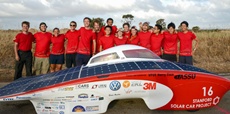Stanford students' solar-powered car placed fourth in international race across the Australian outback
By By Bjorn Carey and Mark Shwartz | Stanford News Se | 14 Oct 2013
Luminos, the solar car built by Stanford students, crossed the Australian outback in five days, finishing fourth overall in the World Solar Challenge. Stanford was the first American team to the finish line and notched the team's best result in decades.
After five grueling days and 2,000 miles on the road, Stanford students jumped for joy as Luminos, their handmade solar racecar, rolled to the finish line of the Bridgestone World Solar Challenge in Adelaide, Australia.
 |
| Stanford students with the solar car team pose with Luminos at the finish line. (Mark Shwartz) |
Luminos was the fourth solar-powered car to complete the international race across the Australian outback â€'' a contest designed to encourage innovation in solar-powered car design â€'' and the first American finisher.
"Placing fourth is great for our team," said Wesley Ford, leader of the student-run Stanford Solar Car Project. "It's probably the best finish that Stanford has had in decades. We're very happy for the car. We're happy for the team. We clocked the race in record time, and we're very, very happy."
The students' strategy of designing the most robust car possible paid dividends throughout the race. The car didn't break down once â€'' a major achievement in solar racing â€'' and sliced through the strong winds that sidelined other cars during the middle stages of the competition.
Entering the final day of racing, Luminos was nipping at the heels of the third-place squad, from the University of Twente and Saxion in the Netherlands. An overcast sky, however, slowed the hot pursuit.
Stanford was one of only four teams to finish on Day 5 of the competition, which began in Darwin on Oct. 6, and reached the end with half an hour to go before the day's mandatory 5 p.m. stop-time. This provided a significant boost in team morale.
As the team reached Adelaide, the temperature dropped significantly, and it had rained much of the afternoon. If the car failed to reach the finish by 5 p.m., they would have been forced to camp along the roadside, as they had the previous four nights in the outback.
"Tonight we'll be back in nice hostels or hotels, get a nice shower, shave again and be looking on to the 2015 race," Ford said
(Also see: Stanford students solar car to race across Australian Outback)






























